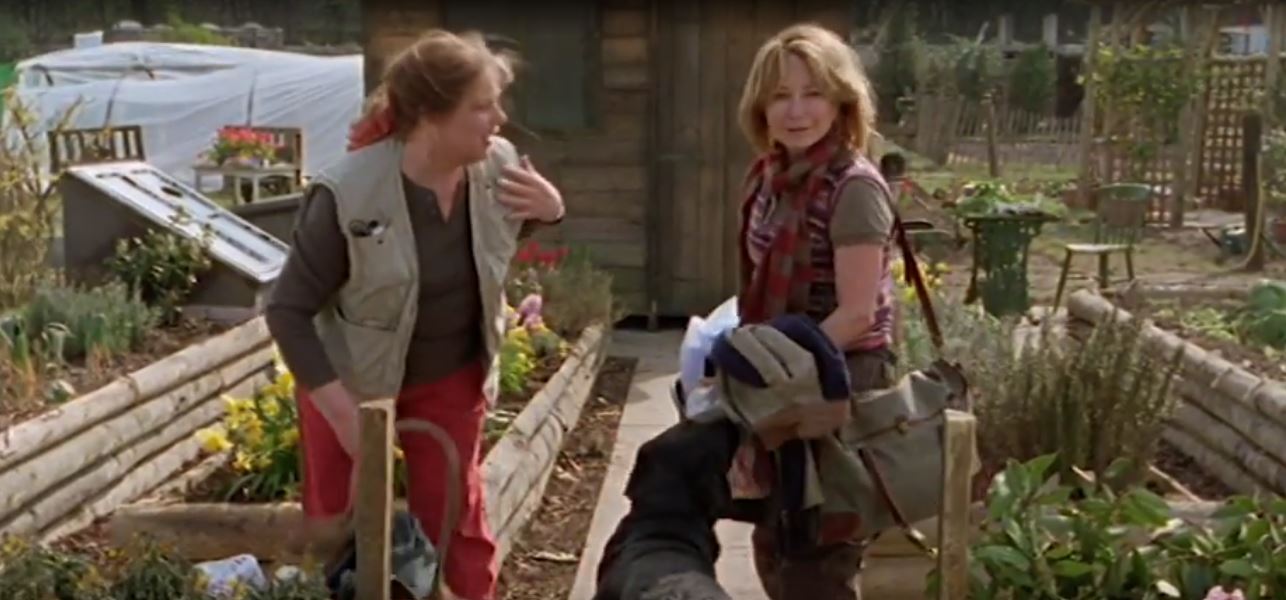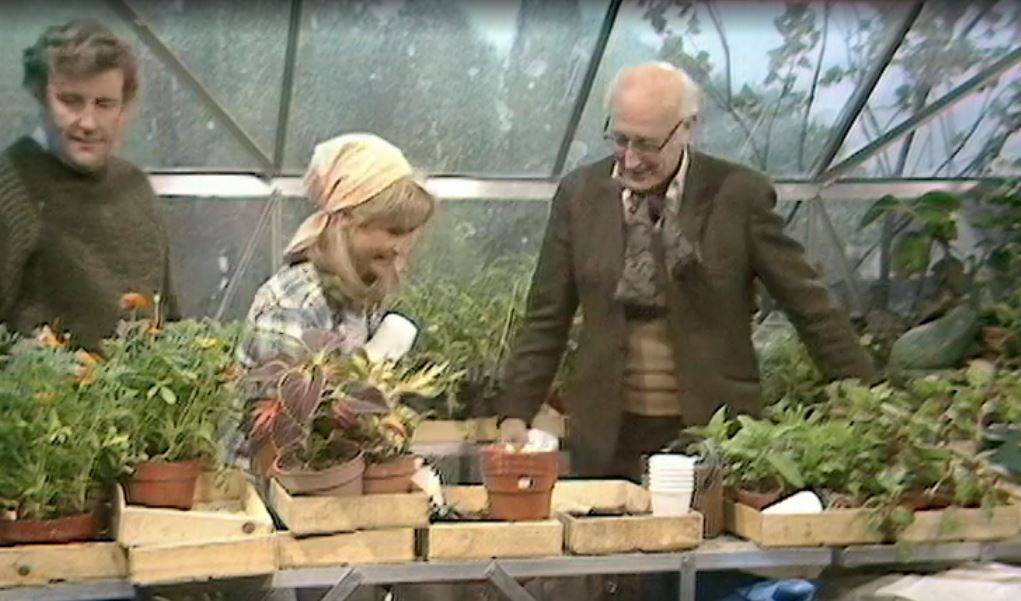
Over on our British TV site, one of the questions that comes up fairly regularly is this: What is an allotment?
As often as it comes up, we figured it would be a good idea to write a short post on the topic.
Table of Contents
What is an Allotment?

We'll start with the basics. An allotment is a plot of land that's divided up in sections which are rented to individuals or families for gardening purposes. The emphasis is on food-growing, but that doesn't mean you'll never see flowers or other plants.
Many allotment-holders like to grow a few flowers, especially those which are good for pollinators. Exact rules about whether you can plant flowers (and how much of your plot can be non-food items) vary from place to place. Some allotments also allow beekeeping, provided it's done by someone with the appropriate training and experience.
Allotments are similar to what most Americans would call “community gardens”, but not quite the same. Many American community gardens are a group effort, rather than a bunch of individual parcels – and in the US, community gardens are usually owned by charities and small community groups, rather than the cities and towns (though of course, there are exceptions).
All of this may seem odd to many Americans with enormous yards, but remember that the UK is a small island (slightly smaller than the state of Oregon). Many people live in flats or have small gardens with little to no room for vegetable growing. Others may have land that's unsuitable (too wet, too shady, bad soil, etc). Allotments are great for giving everyone a chance to work the land and take ownership of some part of the food supply.
Who Owns Allotments?
Allotments are often owned by local government (town or parish councils), but that's not always the case. Some are owned and managed by the allotment holders through an association, and others are owned by the Church of England.
How Big is a Typical Allotment?

Allotment sizes vary by location, but they're generally large enough to provide food for a family. The most common plot size is “10 rods”, which is equal to 1/16 of an acre (302 square yards).
How Much Does it Cost to Have an Allotment?
Just as size varies, allotment fees vary by location, size, and amenities. Because allotments were originally designed to help the poor feed their families, it's always been a priority to keep costs as low as possible.
In Barnsley in South Yorkshire, allotments are currently (May 2021) listed at “£82.17 a year if they have a water supply or £40.49 a year if they don't”.
In Gloucester, a standard full plot is listed at £46.32 per annum, while a half plot is just £23.07 per annum. Concessions are available for some groups (over 65, disabled, etc).
In St. Ives, a full plot is listed at £65/year, while a 1/3 plot is just £22/year.
Given the mental health benefits of gardening, renting a plot in an allotment can be a cost-effective form of therapy, too!
The History of Allotments in the UK

While many countries have some form of allotments, not all countries protect the concept the way the UK does. The concept is said to go back more than 1000 years, back when Saxons would clear woodland to make a common field. As time went on and land ownership became more concentrated in the hands of nobility and churches, it became harder for individuals to grow their own food.
In the late 1500s when Queen Elizabeth I was in power, allotments began to be attached to tenant cottages. Over the next couple hundred years, more people moved into cities and large towns, and more people began to work in industry and service. With no formal social safety net, some people actually starved for lack of access to food.
Eventually, the General Enclosure Act of 1845 included a provision that Commissioners should make provisions for landless individuals to have small gardens – and that's where allotments began to resemble the current system.
In 1887, the Small Holdings and Allotments Act required local authorities to provide allotments if there was demand for them – and because some local authorities resisted, those rules were strengthened over the following decades.
Perhaps the biggest boost to the allotment system, though, was the impact of the two world wars. Demand for allotments skyrocketed when war caused food shortages, and their use contributed greatly to the UK's ability to keep its people fed.
There's been a decline in the use of allotments since the end of World War II, but they're still an important part of British life and culture, and they do come back into fashion from time to time. During the late 70s, for instance, the British TV series The Good Life (aka Good Neighbors in the US) spurred an interest in self-sufficiency and traditional gardening skills.
During the 2020 pandemic, allotment interest again soared as lockdown left people bored, worried, and interested in re-connecting with nature. Sadly, much of the land used for allotments was sold off to developers by past generations, so few areas were able to meet the demand from those hoping to get an allotment.
Allotments in British TV
Because allotments are such an important part of many lives in the UK, it's not uncommon to hear them mentioned in British TV shows. Below, we've gathered up just a few references and appearances we've encountered over the years – though if you pay attention, you'll find they come up quite often.

Shakespeare & Hathaway
In Series 3, Episode 3 of this fun cosy mystery, we see Frank and Luella helping a group of allotment holders who've been threatened with eviction.

Hetty Wainthropp Investigates
Hetty Wainthropp fans will know Hetty and her husband Robert live in a Lancashire terrace house with no front garden and no evidence of any sizable plot in back either. Given their lack of green space, it's no surprise that Robert is quite fond of his spot down at the allotment.
Robert's gardening efforts play into a number of episodes – and at one point, he even tries to earn a bit of extra money selling off some of his harvest.
Sadly, the allotment used in the series was damaged by arsonists back in 2003.

Rosemary & Thyme
In Series 1, Episode 5: “A Simple Plot”, Rosemary introduces Laura to her friend, a blind professor whose allotment plot is having trouble. Plants seem to be randomly dying, and he puts the blame on a nearby building site – and soon after, he's killed in a mysterious accident.

The Good Life (aka Good Neighbors)
While virtually every episode of The Good Life includes mention of their home garden (which they've effectively converted to an allotment) or their allotment plot, one particularly amusing episode is “I Talk to the Trees”, in which Tom and Barbara meet a man down at the allotment who talks to his plants to help them grow. After that, they decide to conduct an experiment of their own…

The Casual Vacancy
In this miniseries based on JK Rowling's novel of the same name, the first episode shows us a village council meeting in which they're discussing the screening process for a new allotment. They suggest the need for character references, plus a bank reference and interview, citing “the tomato blight dispute of '97”.
Save it to Pinterest!
